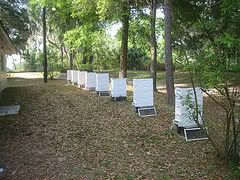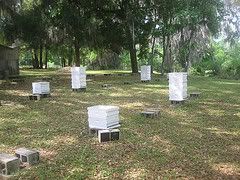Yesterday's trip to the UF Bee Lab

Here are the nucs prior to the bees being installed.

Here is some of the 10 frame colonies. The ones with 2 boxes (supers) are all about to be filled with packages. One package can be seen in-front of the closest hive body. The multiple storied hives (3+) are active colonies. These girls have something to deffend!
This was all completed by 11:00 am, or so, and I would finally see the packages. I walked into the extraction room, used for handling the honey the bees make. Making honey isn't a priority for the Bee Lab but, "bees will be bees". The second the door was opened, there came an ominous roar of thousands...hundreds of thousands of bees. While their noise may scare, with nothing to protect, they're gentle as lambs. All the packages had to be taken outside, placed in the shade and ripped from the wooden strips with hive tools. Then the staples had to be taken out. All this work was done so that the packages would fit inside the new "hives". After some work and splinters, it came time to loosen and take off the wood covers on the packages. The package consists of a wooden box with two screened sides and a hole the size of a large soup can drilled in the top. This is filled with a queen cage attached to a thin strip of metal and plugged with a large can with several holes in the bottom. The can is filled wtih a sugar syrup to keep the bees adaquately fed for 3-4 days. After all the tops were removed we began removing the cans, taking out the queen cages and covering the hole back up with the wooden cover. The packages and queen cages were given matching numbers and the queen were taken inside for marking and clipping. Marking is the process of putting a small drop of paint on top of the thorax of the queen to identify her. Clipping is when one wing is clipped off. Usually, a beekeeper will clip one side on even years and one side on odd ones to be able to guess the age of the queen. When holding the queen, I learned that one must be extremely carfull and gently pinch her by the thorax. Touching the head can dammage sensory organs and holding her by the abdomen can either make her steril or dammage her overies. One must also be carefull when clipping her wings that one of the legs doesn't get in the way of the sisor. The front legs are used to measure the cell to determine if it is to hold a worker or a drone. The back legs support her emmense weight (rellative to her body size) when laying. After the process of marking and clipping was complete they were transfered into small, narrow screened cages. Now they could be introduced into the hives with the workers from the package.
First, the queen would be placed in the hive then the box containing the workers would be placed in the hive aswell. Then the cover on the package would be taken off and the cover of the hive slipped into place above a queen excluder. This process was repeated 20 times. Every time worked just fine with the exception of one nuc which had a badly warped cover. It created a half inch gap at the back, through which bees escaped for about half an hour before it was noticed. When I asked why it was nessesary to screen the enterences, Dr. Hall told me how, last year, they left the enterences open and then came a swarm. All the bees drifted to it and formed a mass from 20 packages ($1000 worth plus shipping). "It was larger than a beachball." He said. Now, with all the new hives set up it was time for the last act of the day. Three queens were being placed in queen bank colonies. Queen banks are colonies used to hold queens for later use. The queens are each confined in their own, individuall screened cages about 1 inch sq. Now, the day was over after a little clean up, and I was sting free. I noticed how, just one year ago I would flinch at the sight of a near by bee, and now, I would open colonies and packages without hessitation.
0 Comments:
Post a Comment
<< Home